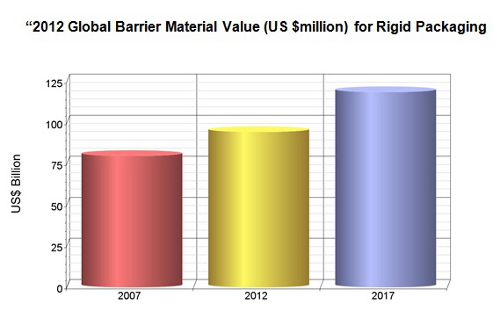
Allied Development Corp. has published Barrier Materials for Rigid Packaging 2013 to 2017, a global industry report which provides in-depth analyses of the barrier materials that are used for the production of rigid barrier packages. The study focuses on seven materials that provide desirable low-level oxygen transmission rates (OTR) between zero and 77.5cc/m2/day (5 cc/100 in2/day). The principal barrier materials reported on in the study include glass containers, PET resin, steel sheet, aluminum sheet, transparent oxide-coated containers, EVOH resin, and nylon resin.
The study calculates that the total combined global market value for all Barrier Materials used in Rigid Packaging was nearly US$95 billion in 2012. Looking forward, the study projects that the global market will grow at an annual rate of 4.7% through 2017.
The study provides in-depth analyses of the underlying technologies of leading barrier materials, including barrier performance metrics and evaluations of innovative technologies, such as nanotechnology and glass tempering, that promise improved product performance.
In the study's Market Analysis section, readers will learn about key drivers and trends affecting the entire industry, along with market data for principal Barrier Materials, 2007 through 2017.
Manufacturing Costs models
One unique aspect of the is its development of detailed Manufacturing Cost models for 330-mL beer containers and closures that are manufactured from different barrier materials, including glass bottles with metal crown caps, two-piece aluminum cans with can ends, two-piece steel cans with can ends, and PET barrier bottles with closures. The analysis rank orders the selected containers from the lowest per-unit Manufactured Cost (aluminum can) to the highest (PET bottle) at commercial volumes. The study also compares the environmental impact of package manufacturing for these same containers.
On a per-unit basis, environmental impact results are mixed. Energy consumption and material to landfill metrics favor the aluminum can. Greenhouse gas releases favor the PET bottle, but water consumption favors the steel can.
Barrier Materials for Rigid Packaging 2013-2017 complements Allied Development's previously published study Barrier Materials for Flexible Packaging 2012-2016. Taken together, these two studies evaluate established and emerging barrier materials that are used by the global packaging industry for both rigid and flexible packaging. The market intelligence contained within these two studies represents a comprehensive and in-depth global perspective on the entire industry.





